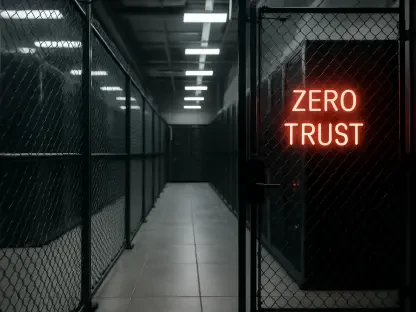In an era where digital streaming dominates entertainment consumption, the discovery of a vast illegal Internet Protocol Television (IPTV) piracy network has sent shockwaves through the industry, revealing a sophisticated operation that undermines legitimate providers. Exposed through meticulous research by cybersecurity experts at Silent Push, this sprawling network encompasses over 1,000 domains and 10,000 IP addresses, positioning it as one of the most extensive piracy infrastructures documented to date. Affecting over 20 major entertainment brands, including giants like Netflix, Prime Video, and Disney Plus, as well as sports channels such as Sky Sports and the Premier League, the scale of this illicit activity is staggering. Beyond the immediate financial blow to legitimate providers, the network poses severe cybersecurity risks to unsuspecting consumers. This revelation underscores a growing challenge as piracy evolves into a sophisticated, global threat, demanding urgent attention from both industry leaders and law enforcement agencies.
The Scale and Impact of IPTV Piracy
Unpacking the Network’s Reach and Operations
The sheer magnitude of this IPTV piracy network is a testament to the audacity and technical prowess of its operators. Spanning thousands of domains and IP addresses, the infrastructure has been active for several years, systematically siphoning content from legitimate streaming services. With a flagship service known as JVTVlive, the network brazenly advertises access to premium content at a fraction of the cost, claiming to operate across 2,000 servers in nearly 200 countries. Such widespread reach not only undermines the revenue streams of entertainment companies but also erodes the value of intellectual property on a global scale. Social media platforms like Facebook and Telegram have become tools for promotion, amplifying the network’s visibility and drawing in users frustrated by the rising costs of legitimate subscriptions. This operation highlights a critical intersection of technological innovation and criminal intent, where affordability becomes a lure for illegal consumption, challenging the sustainability of the streaming industry.
Economic and Brand Damage to Entertainment Giants
Beyond the operational scale, the economic fallout from this piracy network is profound for entertainment giants. The systematic theft of content through illegal restreaming and subscription fraud schemes directly impacts the bottom line of companies that invest billions in original programming and licensing agreements. Brands like HBO and Disney Plus face not only financial losses but also reputational harm as consumers access their content through unauthorized channels, often unaware of the legal and ethical implications. This piracy operation capitalizes on consumer demand for affordable access, a demand exacerbated by escalating subscription fees across multiple platforms. The ripple effect extends to content creators and smaller stakeholders in the industry, who rely on legitimate revenue streams to fund new projects. As piracy networks grow in sophistication, the challenge of protecting intellectual property becomes increasingly complex, necessitating innovative strategies to safeguard both revenue and brand integrity.
Cybersecurity Risks and Legal Responses
Hidden Dangers for Consumers Engaging with Piracy
For consumers tempted by the low costs of services like JVTVlive, the risks extend far beyond legal consequences. Engaging with these illegal IPTV platforms often exposes users to severe cybersecurity threats, including malware distribution, financial fraud, and identity theft. Personal data breaches are a common hazard, with unsuspecting subscribers facing fraudulent credit card charges and compromised sensitive information. The infrastructure behind this piracy network, facilitated by entities such as XuiOne and Tiyansoft based in Herat, Afghanistan, prioritizes profit over user safety, embedding malicious software within streaming services. An individual operator, identified as Nabi Neamati, has been linked to the operation, advertising IPTV configuration services across freelance platforms, further expanding the network’s reach. This underscores a critical need for public awareness about the hidden perils of piracy, as the promise of cheap entertainment often comes at a steep, unseen cost to personal security.
Legal Actions and Industry Efforts to Combat Piracy
Efforts to dismantle such piracy networks have gained momentum through recent legal actions and industry initiatives. In the U.K., authorities have cracked down on illegal streaming, with a notable two-year prison sentence handed to an individual selling preloaded Amazon Fire sticks. Similarly, Greece has introduced stringent anti-piracy laws, imposing fines up to €750 for violations, while U.K. police conducted targeted raids on Sky TV IPTV operations in recent months. These actions reflect a broader commitment to curbing digital piracy, yet the global nature of these networks complicates enforcement. The entertainment industry, in parallel, is exploring technological solutions to protect content, from advanced encryption to watermarking techniques. However, the root cause—consumer demand driven by high subscription costs—remains a hurdle. Addressing this issue requires a dual approach of stricter enforcement and innovative pricing models to make legitimate services more accessible, ensuring that piracy loses its appeal over time.
Reflections on a Persistent Digital Threat
Lessons Learned from a Sprawling Investigation
Looking back, the investigation by Silent Push into this vast IPTV piracy network revealed the alarming sophistication and global reach of illicit streaming operations. The detailed findings exposed not just the scale—over 1,000 domains and 10,000 IP addresses—but also the specific entities and individuals driving the scheme, painting a clear picture of a well-organized criminal enterprise. The economic damage to major entertainment brands was staggering, with millions in potential revenue lost to illegal restreaming and fraud. Equally concerning were the cybersecurity threats posed to consumers, who often unknowingly traded personal security for cheap access to premium content. This case served as a stark reminder of the dual impact of piracy, harming both industry giants and individual users. It became evident that isolated legal actions, while impactful, were insufficient against a network spanning nearly 200 countries, highlighting the need for a coordinated, international response.
Future Strategies to Mitigate Piracy Challenges
Reflecting on the aftermath, the path forward demanded stronger cybersecurity measures and global cooperation to dismantle such networks effectively. Governments and industry leaders recognized the urgency of developing robust frameworks for content protection, from enhanced digital rights management to real-time monitoring of piracy domains. Equally important was addressing the consumer demand fueling these operations, which often stemmed from the high cost of legitimate subscriptions. Initiatives to offer affordable, flexible pricing models emerged as a potential solution to steer users away from illegal alternatives. Public education campaigns also gained traction, aiming to inform users about the risks of malware and data theft tied to piracy. As technology continued to evolve, so too did the strategies to combat digital threats, with a clear focus on balancing enforcement with accessibility to ensure the entertainment industry could thrive without compromising consumer safety.









